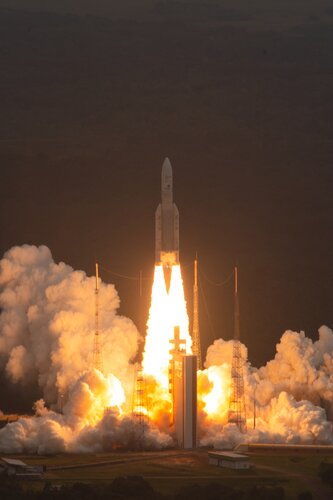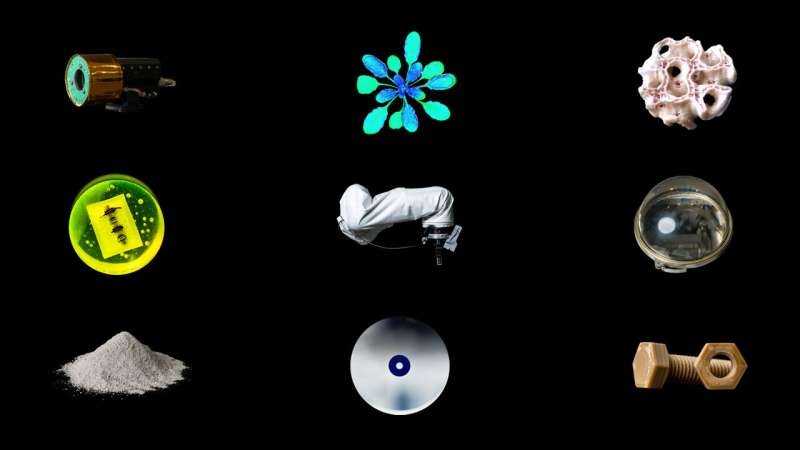
Copernical Team
Precise Ariane 5 launch likely to extend Webb's expected lifetime

After a successful launch of the NASA/ESA/CSA James Webb Space Telescope on 25 December, and completion of two mid-course correction manoeuvres, the Webb team has analysed its initial trajectory and determined the observatory should have enough propellant to allow support of science operations in orbit for significantly more than a 10-year lifetime (the minimum baseline for the mission is five years).
With its single 'eye,' NASA's DART returns first images from space

Just two weeks after launching from Vandenberg Space Force Base in California, NASA's Double Asteroid Redirection Test (DART) spacecraft has opened its "eye" and returned its first images from space—a major operational milestone for the spacecraft and DART team.
After the violent vibrations of launch and the extreme temperature shift to minus 80 degrees C in space, scientists and engineers at the mission operations center at the Johns Hopkins Applied Physics Laboratory in Laurel, Maryland, held their breath in anticipation. Because components of the spacecraft's telescopic instrument are sensitive to movements as small as 5 millionths of a meter, even a tiny shift of something in the instrument could be very serious.
An icy spring at the Martian South Pole
 In addition to its enormous volcanoes, huge rift valley systems, and dried-up crater lakes and river valleys, the ice caps at the north and south poles of Mars have been the subject of intensive scientific investigations. These ice caps, which grow in the winter and shrink in the spring and summer, are also a distinctly aesthetic sight. This image, created using data acquired by the German Aeros
In addition to its enormous volcanoes, huge rift valley systems, and dried-up crater lakes and river valleys, the ice caps at the north and south poles of Mars have been the subject of intensive scientific investigations. These ice caps, which grow in the winter and shrink in the spring and summer, are also a distinctly aesthetic sight. This image, created using data acquired by the German Aeros AFRL, Northrop Grumman demonstrate solar to radio frequency conversion
 The Air Force Research Laboratory's and Northrop Grumman's Space Solar Power Incremental Demonstrations and Research (SSPIDR) Project have successfully conducted the first end-to-end demonstration of key hardware for the Arachne flight experiment.
A ground demonstration of novel components for the "sandwich tile" were used to successfully convert solar energy to radio frequency (RF) - a fu
The Air Force Research Laboratory's and Northrop Grumman's Space Solar Power Incremental Demonstrations and Research (SSPIDR) Project have successfully conducted the first end-to-end demonstration of key hardware for the Arachne flight experiment.
A ground demonstration of novel components for the "sandwich tile" were used to successfully convert solar energy to radio frequency (RF) - a fu NASA's Webb Telescope Keeping Cool with Ultra-thin DuPont Kapton Polyimide Films
 After 30 years in development, the National Aeronautics Space Administration's (NASA) James Webb Space Telescope (JWST) was launched on December 25, 2021, from the European Space Agency's launch site at Kourou in French Guiana. DuPont technology, in the form of ultra-thin Kapton polyimide films, is the crucial material protecting the JWST from the light and the heat of the sun, enabling it to fu
After 30 years in development, the National Aeronautics Space Administration's (NASA) James Webb Space Telescope (JWST) was launched on December 25, 2021, from the European Space Agency's launch site at Kourou in French Guiana. DuPont technology, in the form of ultra-thin Kapton polyimide films, is the crucial material protecting the JWST from the light and the heat of the sun, enabling it to fu Perseverance Samples in Review: 2021
 As the 2021 calendar year comes to a close, it's nice to sit back and reflect on all the progress we've made on Mars this year. It's been a busy ~300 sols for both Perseverance and our helicopter sidekick, Ingenuity!
One of Perseverance's mission objectives is to collect and store samples of the martian surface for eventual return back to Earth as part of the Mars Sample Return campaign. T
As the 2021 calendar year comes to a close, it's nice to sit back and reflect on all the progress we've made on Mars this year. It's been a busy ~300 sols for both Perseverance and our helicopter sidekick, Ingenuity!
One of Perseverance's mission objectives is to collect and store samples of the martian surface for eventual return back to Earth as part of the Mars Sample Return campaign. T Webb Telescope Aft Sunshield Pallet Deployed
 Webb is beginning to resemble the form it will take when it is fully deployed - now that the mission operations team has successfully deployed and latched into place the observatory's forward and aft Unitized Pallet Structures.
The team began working through the deployment of the forward pallet this morning, concluding at approximately 1:21 p.m. EST. The team then moved on to the aft palle
Webb is beginning to resemble the form it will take when it is fully deployed - now that the mission operations team has successfully deployed and latched into place the observatory's forward and aft Unitized Pallet Structures.
The team began working through the deployment of the forward pallet this morning, concluding at approximately 1:21 p.m. EST. The team then moved on to the aft palle 99 objects telling tales from ESA's technical heart

From simulated moondust to an ultraflat floor, a 3D-printed human bone to a wall decoration that once flew on the Hubble Space Telescope, the new 99 Objects of ESA ESTEC website gives visitors a close-up view of intriguing, often surprising artifacts assembled together to tell the story of ESA's technical heart.
"Objects are what matter," famed anthropologist Claude Lévi-Strauss once wrote. "Only they carry the evidence that throughout the centuries something really happened among human beings." So what manner of objects come out of more than half a century of activity at Europe's biggest space center?
The European Space Research and Technology Centre, ESTEC, is ESA's singe largest establishment, based on the North Sea coast at Noordwijk in the Netherlands.
Often described as the technical heart of ESA, ESTEC is where most ESA projects are born and where they are guided through the various phases of development.
UK firm closer to offering global internet via satellites
 A Russian Soyuz rocket on Monday took 36 more satellites from British operator OneWeb into orbit, bringing the company more than halfway towards its goal of providing global broadband internet.
The London-headquartered company is working to complete the construction of a constellation of low earth orbit satellites providing enhanced broadband and other services to countries around the planet
A Russian Soyuz rocket on Monday took 36 more satellites from British operator OneWeb into orbit, bringing the company more than halfway towards its goal of providing global broadband internet.
The London-headquartered company is working to complete the construction of a constellation of low earth orbit satellites providing enhanced broadband and other services to countries around the planet China slams US after space station 'close encounters' with Musk's satellites
 Beijing on Tuesday accused the United States of irresponsible and unsafe conduct in space over two "close encounters" between the Chinese space station and satellites operated by Elon Musk's SpaceX.
Tiangong, China's new space station, had to manoeuvre to avoid colliding with one Starlink satellite in July and with another in October, according to a note submitted by Beijing to the United Na
Beijing on Tuesday accused the United States of irresponsible and unsafe conduct in space over two "close encounters" between the Chinese space station and satellites operated by Elon Musk's SpaceX.
Tiangong, China's new space station, had to manoeuvre to avoid colliding with one Starlink satellite in July and with another in October, according to a note submitted by Beijing to the United Na 
































